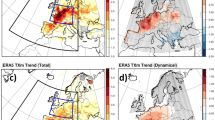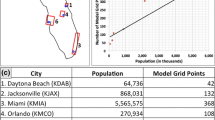Abstract
An extraordinary and unprecedented heatwave swept across western North America (i.e., the Pacific Northwest) in late June of 2021, resulting in hundreds of deaths, a massive die-off of sea creatures off the coast, and horrific wildfires. Here, we use observational data to find the atmospheric circulation variabilities of the North Pacific and Arctic-Pacific-Canada patterns that co-occurred with the development and mature phases of the heatwave, as well as the North America pattern, which coincided with the decaying and eastward movement of the heatwave. Climate models from the Coupled Model Intercomparison Project (Phase 6) are not designed to simulate a particular heatwave event like this one. Still, models show that greenhouse gases are the main reason for the long-term increase of average daily maximum temperature in western North America in the past and future.
摘 要
2021 年 6 月底至7月初, 北美西部发生了一次前所未有的超级热浪事件, 多地的气温打破了有观测以来的历史纪录. 此次超级热浪事件导致了数百人死亡, 造成了大量的沿海生物死亡, 引发了严重的森林野火. 利用逐日的大气再分析资料, 我们发现大气环流异常引起的 “热穹顶” 对本次超级热浪事件的形成与演变有着重要的作用. 其中, 北太平洋型环流异常、 极地-太平洋-加拿大型环流异常对应着热浪事件的发展与成熟, 而北美型环流异常对应着热浪事件的衰退与东移. 除了自然变率, 本次北美热浪事件也受到人为强迫的影响. 利用第六次国际耦合模式比较计划 (CMIP6) 中检测归因模式比较计划 (DAMIP) 的模式数据, 我们发现, 从长期来看, 以温室气体为主的人类活动是北美西部日最高气温过去和未来增长的主要原因. 如果不采取适当的减排措施, 以往百年一遇的超级热浪事件在未来将会变成常态, 并将严重威胁人类健康与生态平衡.
Article PDF
Similar content being viewed by others
Avoid common mistakes on your manuscript.
Data availability. All data in the main text or the Supplementary information and Methods are available. In the main text, NCEP/NCAR reanalysis data are available athttps://psl.noaa.gov/data/gridded/data.ncep.reanalysis.html. GHCND observation data are available at ftp:/fftp.ncdc.noaa.gov/pub/data/ghcn/dally/grid/. CMIP6 model data are available at https://esgf-node.llnl.gov/projects/cmip6/. The NOAA OISST high-resolution dataset, which is v2.0 over 1982–2015 and v2.1 over 2016–21, is available at https://psl.noaa.gov/data/gridded/data.noaa.oisst.v2.highres.html.
References
Black, E., M. Blackburn, G. Harrison, B. Hoskins, and J. Methven, 2004: Factors contributing to the summer 2003 European heatwave. Weather, 59, 217–223, https://doi.org/10.1256/wea.74.04.
Chen, R. D., Z. P. Wen, R. Y. Lu, and C. Z. Wang, 2019: Causes of the extreme hot midsummer in central and South China during 2017: Role of the western Tropical Pacific warming. Adv. Atmos. Sci., 36, 465–478, https://doi.org/10.1007/s00376-018-8177-4.
Deng, K. Q., S. Yang, M. F. Ting, P. Zhao, and Z. Y. Wang, 2019: Dominant modes of China summer heat waves driven by global sea surface temperature and atmospheric internal variability. J. Climate, 32, 3761–3775, https://doi.org/10.1175/JCLI-D-18-0256.1.
Fischer, E. M., and R. Knutti, 2015: Anthropogenic contribution to global occurrence of heavy-precipitation and high-temperature extremes. Nature Climate Change, 5, 560–564, https://doi.org/10.1038/nclimate2617.
Fischer, E. M., S. Sippel, and R. Knutti, 2021: Increasing probability of record-shattering climate extremes. Nature Climate Change, 11, 689–695, https://doi.org/10.1038/s41558-021-01092-9.
Folland, C. K., J. Knight, H. W. Linderholm, D. Fereday, S. Ineson, and J. W. Hurrell, 2009: The summer North Atlantic Oscillation: Past, present, and future. J. Climate, 22(5), 1082–1103, https://doi.org/10.1175/2008JCLI2459.1.
Gessner, C., E. M. Fischer, U. Beyerle, and R. Knutti, 2021: Very rare heat extremes: Quantifying and understanding using ensemble reinitialization. J. Climate, 34, 6619–6634, https://doi.org/10.1175/JCLI-D-20-0916.1.
Gillett, N. P., and Coauthors, 2016: The detection and attribution model intercomparison project (DAMIP v1.0) contribution to CMIP6. Geoscientific Model Development, 9, 3685–3697, https://doi.org/10.5194/gmd-9-3685-2016.
Horton, D. E., N. C. Johnson, D. Singh, D. L. Swain, B. Rajaratnam, and N. S. Diffenbaugh, 2015: Contribution of changes in atmospheric circulation patterns to extreme temperature trends. Nature, 522, 465–469, https://doi.org/10.1038/nature14550.
IPCC, 2013: Climate Change 2013: The Physical Science Basis. Contribution of Working Group I to the Fifth Assessment Report of the Intergovernmental Panel on Climate Change. Stocker et al., Eds., Cambridge University Press, 1535 pp.
IPCC, 2021: Climate Change 2021: The Physical Science Basis. Contribution of Working Group I to the Sixth Assessment Report of the Intergovernmental Panel on Climate Change. Cambridge University Press.
Kalnay, E., and Coauthors, 1996: The NCEP/NCAR 40-year reanalysis project. Bull. Amer. Meteor. Soc., 77, 437–472, https://doi.org/10.1175/1520-0477(1996)077<0437:TNYRP>2.0.CO;2.
Kim, B.-M., S.-W. Son, S.-K. Min, J.-H. Jeong, S.-J. Kim, X. D. Zhang, T. Shim, and J.-H. Yoon, 2014: Weakening of the stratospheric polar vortex by Arctic sea-ice loss. Nature Communications, 5, 4646, https://doi.org/10.1038/ncomms5646.
Lau, N.-C., and M. J. Nath, 2012: A model study of heat waves over North America: Meteorological aspects and projections for the twenty-first century. J. Climate, 25, 4761–4784, https://doi.org/10.1175/JCLI-D-11-00575.1.
Li, J. P., and C. Q. Ruan, 2018: The North Atlantic—Eurasian tele-connection in summer and its effects on Eurasian climates. Environmental Research Letters, 13, 024007, https://doi.org/10.1088/1748-9326/aa9d33.
Li, J. P., F. Zheng, C. Sun, J. Feng, and J. Wang, 2019: Pathways of influence of the northern Hemisphere Mid-high latitudes on East Asian Climate: A review. Adv. Atmos. Sci., 36, 902–921, https://doi.org/10.1007/s00376-019-8236-5.
Ma, S. M., T. J. Zhou, D. A. Stone, O. Angélil, and H. Shiogama, 2017: Attribution of the July–August 2013 heat event in Central and Eastern China to anthropogenic greenhouse gas emissions. Environmental Research Letters, 12(5), 054020, https://doi.org/10.1088/1748-9326/aa69d2.
Menne, M. J., I. Durre, R. S. Vose, B. E. Gleason, and T. G. Houston, 2012: An overview of the global historical climatology network-daily database. J. Atmos. Ocean. Technol., 29, 897–910, https://doi.org/10.1175/JTECH-D-11-00103.1.
Nakamura, T., K. Yamazaki, K. Iwamoto, M. Honda, Y. Miyoshi, Y. Ogawa, and J. Ukita, 2015: A negative phase shift of the winter AO/NAO due to the recent Arctic sea-ice reduction in late autumn. J. Geophys. Res., 120, 3209–3227, https://doi.org/10.1002/2014JD022848.
Overland, J. E., 2021: Causes of the record-breaking Pacific Northwest Heatwave, Late June 2021. Atmosphere, 12(11), 1434, https://doi.org/10.3390/atmos12111434.
Peings, Y., and G. Magnusdottir, 2014: Response of the wintertime northern hemisphere atmospheric circulation to current and projected Arctic Sea Ice Decline: A numerical study with CAM5. J. Climate, 27, 244–264, https://doi.org/10.1175/JCLI-D-13-00272.1.
Perkins, S. E., L. V. Alexander, and J. R. Nairn, 2012: Increasing frequency, intensity and duration of observed global heatwaves and warm spells. Geophys. Res. Lett., 39, L20714, https://doi.org/10.1029/2012GL053361.
Perkins-Kirkpatrick, S. E., and S. C. Lewis, 2020: Increasing trends in regional heatwaves. Nature Communications, 11, 3357, https://doi.org/10.1038/s41467-020-16970-7.
Philip, S. Y., and Coauthors, 2022: Rapid attribution analysis of the extraordinary heatwave on the Pacific coast of the US and Canada June 2021. Earth System Dynamics, https://doi.org/10.5194/esd-2021-90.
Ramamurthy, P., J. González, L. Ortiz, M. Arend, and F. Moshary, 2017: Impact of heatwave on a megacity: An observational analysis of New York City during July 2016. Environmental Research Letters, 12, 054011, https://doi.org/10.1088/1748-9326/aa6e59.
Reynolds, R. W., T. M. Smith, C. Y. Liu, D. B. Chelton, K. S. Casey, and M. G. Schlax, 2007: Daily high-resolution-blended analyses for sea surface temperature. J. Climate, 20, 5473–5496, https://doi.org/10.1175/2007JCLI1824.1.
Seong, M.-G., S.-K. Min, Y.-H. Kim, X.-B. Zhang, and Y. Sun, 2021: Anthropogenic greenhouse gas and aerosol contributions to extreme temperature changes during 1951–2015. J. Climate, 34, 857–870, https://doi.org/10.1175/JCLI-D-19-1023.1.
Stott, P. A., D. A. Stone, and M. R. Allen, 2004: Human contribution to the European heatwave of 2003. Nature, 432, 610–614, https://doi.org/10.1038/nature03089.
Sturaro, G. 2003: A closer look at the climatological discontinuities present in the NCEP/NCAR reanalysis temperature due to the introduction of satellite data. Climate Dyn., 21, 309–316. https://doi.org/10.1007/s00382-003-0334-4.
Takaya, K., and H. Nakamura, 2001: A formulation of a phase-independent wave-activity flux for stationary and migratory quasigeostrophic eddies on a zonally varying basic flow. J. Atmos. Sci., 58, 608–627, https://doi.org/10.1175/1520-0469(2001)058<0608:AFOAPI>2.0.CO;2.
Wang, B., B. Q. Xiang, and J. Y. Lee, 2013: Subtropical high predictability establishes a promising way for monsoon and tropical storm predictions. Proceedings of the National Academy of Sciences of the United States of America, 110, 2718–2722, https://doi.org/10.1073/pnas.1214626110.
Wang, C. Z., Y. L. Yao, H. L. Wang, X. B. Sun, and J. Y. Zheng, 2021: The 2020 summer floods and 2020/21 winter extreme cold surges in China and the 2020 typhoon season in the western North Pacific. Adv. Atmos. Sci., 38, 896–904, https://doi.org/10.1007/s00376-021-1094-y.
Wang, J., Y. Chen, S. F. B. Tett, Z. W. Yan, P. M. Zhai, J. M. Feng, and J. J. Xia, 2020: Anthropogenically-driven increases in the risks of summertime compound hot extremes. Nature Communications, 11, 528, https://doi.org/10.1038/s41467-019-14233-8.
Wang, P. Y., J. P. Tang, X. G. Sun, S. Y. Wang, J. Wu, X. N. Dong, and J. Fang, 2017: Heat waves in China: Definitions, leading patterns, and connections to large-scale atmospheric circulation and SSTs. J. Geophys. Res., 122, 10679–10699. https://doi.org/10.1002/2017JD027180.
Wu, Z. W., H. Lin, J. P. Li, Z. H. Jiang, and T. T. Ma, 2012: Heat wave frequency variability over North America: Two distinct leading modes. J. Geophys. Res., 117, D02102, https://doi.org/10.1029/2011JD016908.
Zheng, J. Y., and C. Z. Wang, 2019: Hot summers in the northern Hemisphere. Geophys. Res. Lett., 46, 10891–10900. https://doi.org/10.1029/2019GL084219.
Zhou, G. D., 2019: Atmospheric response to sea surface temperature anomalies in the mid-latitude oceans: A brief review. Atmosphere-Ocean, 57(5), 319–328, https://doi.org/10.1080/07055900.2019.1702499.
Acknowledgements
This study is supported by the Key Special Project for Introduced Talents Team of Southern Marine Science and Engineering Guangdong Laboratory (Guangzhou) (GML2019ZD0306), National Natural Science Foundation of China (Grant Nos. 41731173 and 42192564), National Key R&D Program of China (2019YFA0606701), Strategic Priority Research Program of Chinese Academy of Sciences (XDB42000000 and XDA20060502), Innovation Academy of South China Sea Ecology and Environmental Engineering, Chinese Academy of Sciences (ISEE2021ZD01), Independent Research Project Program of State Key Laboratory of Tropical Oceanography (Grand No. LTOZZ2004), and Leading Talents of Guangdong Province Program. The numerical simulations were supported by the High Performance Computing Division in the South China Sea Institute of Oceanology.
Author information
Authors and Affiliations
Corresponding authors
Additional information
Article Highlights
• The North Pacific and Arctic-Pacific-Canada patterns co-occur with the development and mature phases of the heatwave in western North America.
• The North America pattern coincides with the decaying and eastward movement of the heatwave in western North America.
• Greenhouse gases are a main reason for the average daily maximum temperature increase in the past and future.
Rights and permissions
Open Access This article is licensed under a Creative Commons Attribution 4.0 International License, which permits use, sharing, adaptation, distribution and reproduction in any medium or format, as long as you give appropriate credit to the original author(s) and the source, provide a link to the Creative Commons licence, and indicate if changes were made. The images or other third party material in this article are included in the article’s Creative Commons licence, unless indicated otherwise in a credit line to the material. If material is not included in the article’s Creative Commons licence and your intended use is not permitted by statutory regulation or exceeds the permitted use, you will need to obtain permission directly from the copyright holder. To view a copy of this licence, visit http://creativecommons.org/licenses/by/4.0/.
About this article
Cite this article
Wang, C., Zheng, J., Lin, W. et al. Unprecedented Heatwave in Western North America during Late June of 2021: Roles of Atmospheric Circulation and Global Warming. Adv. Atmos. Sci. 40, 14–28 (2023). https://doi.org/10.1007/s00376-022-2078-2
Received:
Revised:
Accepted:
Published:
Issue Date:
DOI: https://doi.org/10.1007/s00376-022-2078-2




